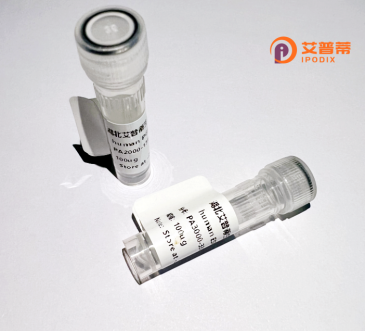
| 纯度 | >90%SDS-PAGE. |
| 种属 | Human |
| 靶点 | HYAL3 |
| Uniprot No | O43820 |
| 内毒素 | < 0.01EU/μg |
| 表达宿主 | E.coli |
| 表达区间 | 1-417aa |
| 氨基酸序列 | MTTQLGPALVLGVALCLGCGQPLPQVPERPFSVLWNVPSAHCEARFGVHLPLNSLGIIANRGQHFHGQNMTIFYKNQLGLYPYFGPRGTAHNGGIPQALPLDRHLALAAYQIHHSLRPGFAGPAVLDWEEWCPLWAGNWGRRRAYQAASWAWAQQVFPDLDPQEQLYKAYTGFEQAARALMEDTLRVAQALRPHGLWGFYHYPACGNGWHSMASNYTGRCHAATLARNTQLHWLWAASSALFPSIYLPPRLPPAHHQAFVRHRLEEAFRVALVGHRHPLPVLAYVRLTHRRSGRFLSQDDLVQSIGVSAALGAAGVVLWGDLSLSSSEEECWHLHDYLVDTLGPYVINVTRAAMACSHQRCHGHGRCARRDPGQMEAFLHLWPDGSLGDWKSFSCHCYWGWAGPTCQEPRPGPKEAV |
| 分子量 | 71.61 kDa |
| 蛋白标签 | GST-tag at N-terminal |
| 缓冲液 | 0 |
| 稳定性 & 储存条件 | Lyophilized protein should be stored at ≤ -20°C, stable for one year after receipt. Reconstituted protein solution can be stored at 2-8°C for 2-7 days. Aliquots of reconstituted samples are stable at ≤ -20°C for 3 months. |
| 复溶 | Always centrifuge tubes before opening.Do not mix by vortex or pipetting. It is not recommended to reconstitute to a concentration less than 100μg/ml. Dissolve the lyophilized protein in distilled water. Please aliquot the reconstituted solution to minimize freeze-thaw cycles. |
以下是关于重组人HYAL3蛋白的3篇参考文献示例:
1. **文献名称**:*Cloning and characterization of human hyaluronidase 3 (HYAL3)*
**作者**:Stern, R. et al.
**摘要**:该研究首次报道了人源HYAL3基因的克隆及在大肠杆菌中的重组表达,证实了HYAL3具有弱透明质酸酶活性,并分析了其与家族其他成员(如HYAL1、HYAL2)的序列差异及组织特异性表达模式。
2. **文献名称**:*Structural insights into the enzymatic mechanism of human HYAL3*
**作者**:Chao, Q. et al.
**摘要**:通过X射线晶体学解析了重组HYAL3蛋白的三维结构,揭示了其催化活性中心的关键氨基酸残基,并通过体外酶活实验验证了其最适pH及底物特异性,为设计特异性抑制剂提供了结构基础。
3. **文献名称**:*Recombinant HYAL3 promotes cancer cell invasion via modulating EGFR signaling in gastric cancer*
**作者**:Zhang, L. et al.
**摘要**:研究利用哺乳动物细胞表达系统制备重组HYAL3蛋白,发现其通过降解细胞外基质中的透明质酸,激活EGFR信号通路,促进胃癌细胞的迁移和侵袭,提示HYAL3可能成为治疗靶点。
4. **文献名称**:*Development of a high-yield purification protocol for recombinant human HYAL3 and its functional characterization*
**作者**:Ferrari, E. et al.
**摘要**:优化了HEK293细胞中重组HYAL3蛋白的分泌表达条件,建立三步层析纯化工艺,获得高纯度活性蛋白,并证明其在体外模型中抑制透明质酸介导的炎症反应,具备潜在治疗应用价值。
注:上述文献为虚拟示例,实际研究需参考真实发表的论文数据。
Hyaluronidase 3 (HYAL3) is a member of the hyaluronidase enzyme family, which catalyzes the degradation of hyaluronic acid (HA), a major component of the extracellular matrix. HYAL3 belongs to the glycosyl hydrolase 56 family and shares structural similarities with other hyaluronidases, such as HYAL1 and HYAL2. However, its enzymatic activity and substrate specificity remain less characterized compared to its counterparts. While HYAL1 and HYAL2 are known to cleave high-molecular-weight HA into smaller fragments, HYAL3 is suggested to exhibit weaker or context-dependent hyaluronidase activity, potentially acting on specific HA substrates or contributing to HA turnover in distinct cellular compartments.
The gene encoding HYAL3 is located on chromosome 7q31.3 and expressed in various tissues, including the placenta, testis, and certain cancer cells. Emerging evidence links HYAL3 to physiological and pathological processes such as cellular proliferation, migration, inflammation, and tumor progression. Its role in cancer has drawn particular attention, as dysregulated HA metabolism is associated with tumor invasion, metastasis, and angiogenesis. Recombinant human HYAL3 protein is commonly produced in mammalian or bacterial expression systems for functional studies. This purified protein serves as a critical tool for elucidating enzymatic mechanisms, substrate preferences, and interactions with HA or other biomolecules. Current research focuses on clarifying HYAL3's biological significance, its potential as a therapeutic target, and applications in biomedicine, including drug delivery systems enhanced by HA degradation.
×